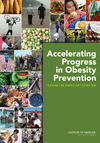 This week in Washington, at the Centers for Disease Control and Prevention’s 2012 WEIGHT OF THE NATION conference, the Institute of Medicine released a new report, “Accelerating Progress in Obesity Prevention: Solving the Weight of the Nation.”
This week in Washington, at the Centers for Disease Control and Prevention’s 2012 WEIGHT OF THE NATION conference, the Institute of Medicine released a new report, “Accelerating Progress in Obesity Prevention: Solving the Weight of the Nation.”
The report, which is available online (and which includes a link to a nifty infographic) sets out five goals that, if met, would ensure we as a nation don’t falter in our fight against the obesity epidemic:
- Integrate physical activity every day in every way
- Market what matters for a healthy life
- Make healthy foods and beverages available everywhere
- Activate employers and health care professionals
- Strengthen schools as the heart of health
The report also urges all sectors of society to work together to achieve these goals.
These goals have been laid out before, in slightly different language, by local, state and federal agencies and health organizations — including cancer charities like AICR (because preventing obesity would mean preventing approximately 100,000 US cancers every year).The goals are well known in policy circles, as are many strategies for attaining them. There’s a lot of different issues gumming up the works, however, according to several people I spoke with at the conference. For example, we need to secure the necessary buy-in from the food industry and schools (who are already stretched to their limits, in terms of staff, time and resource).
One of the IOM report’s goals, for example, is to make schools “the heart of health,” meaning that students should engage in 60 minutes of activity every day, that nutrition should be part of the curricula, and that federal nutrition standards should be rigorously implemented.
But in the CDC conferences many breakout sessions, local and state governments presented on a host of low-cost or no-cost pilot programs for getting schools more active. Over and over again, however, every presenter who reported on such a program — even the most successful ones — noted that “the parental relationship was labor and resource intensive.” That’s policy-speak for: getting parents involved is challenging.
Even so, the IOM is an objective and well-respected body, and most of the conferences attendees I spoke to were hopeful that, given the current receptiveness in Washington to the need for prevention policy, this report might make a real difference.
Another thing that might make a difference — the HBO documentary Weight of the Nation, produced in partnership with the CDC. The members of the IOM committee were particularly pleased with the documentary, noting that it has the potential to reach millions of people and change behaviors.





